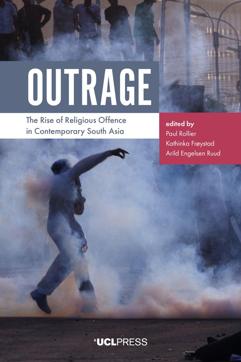Review: Outrage; The Rise of Religious Offence in Contemporary South Asia edited by P Rollier, K Froystad, AE Ruud
Without reducing religious offence controversies to battles between tradition and modernity, or between faith and freedom of expression, a new book of essays looks at how struggles for power in India, Pakistan, Bangladesh and Myanmar are shaped by history

How do we navigate the complex terrain of artistic freedom, religious faith and identity politics when hurt sentiments are part of the picture? Should mythological and religious figures be treated in the same way as literary characters? Do artists have a responsibility to not offend? Why do people get offended in the first place? What makes believers ready to kill in order to protect their faith? These provocative questions lie at the heart of a new book called Outrage: The Rise of Religious Offence in Contemporary South Asia, published by UCL Press.
Edited by Paul Rollier, Kathinka Frøystad and Arild Engelsen Ruud, it consists of nine chapters and case studies from India, Pakistan, Bangladesh and Myanmar. What is most refreshing about this volume is that it does not reduce religious offence controversies to merely a battle between the right and the left, or between tradition and modernity, or between faith and freedom of expression. It considers all these factors but veers away from simplistic conclusions. It is curious to uncover how struggles for power in the present moment are shaped by the legacy of colonialism, which is shared by all the four countries mentioned earlier.
The authors who have contributed chapters to this publication -- Asad Ali Ahmed, Kathinka Frøystad, Iselin Frydenlund, Ute Hüsken, Paul Rollier, Arild Engelsen Ruud, Jürgen Schaflechner and Moumita Sen -- bring together expertise from a variety of interrelated disciplines such social anthropology, religious studies, postcolonial studies, gender studies, visual studies and South Asian studies. While this would offer tremendous intellectual stimulation for academics, it can alienate readers who do not have the training or patience to wade through dense scholarly material. The exhaustive introduction is a helpful entry point.
Apart from enquiring into how laws enacted by the British continue to guide contemporary debates around minority rights, blasphemy and maintenance of public order, this book focuses on the online circulation of potentially offensive material. Though journalism often becomes the punching bag, the profusion of social media has increased the number of content creators and publishers, and the volume of unverified material that travels across the globe in a fraction of seconds. The chapters discuss how this very democratization of the public sphere has also created conditions for undemocratic forces to flourish -- Muslims being lynched by Hindus in India, atheists being hacked to death by Muslims in Bangladesh, Christians and Ahmadis being killed by Sunnis in Pakistan.
How are concepts such as heresy, sacrilege, blasphemy and desecration linked to each other? Do they mean the same in Abrahamic and non-Abrahamic religious contexts? When do states deploy non-state actors, particularly religious leaders, to carry out their hidden mandate to foment conflict between different communities? What are secular courts supposed to do when people with hurt religious sentiments mobilize in millions, and the collective emotional tsunami unleashed as a result threatens to cause large scale violence? This book does a fine job of opening up such questions for reflection and further research.
Outrage: The Rise of Religious Offence in Contemporary South Asia tries to unravel each case in all its complexity and reminds us that religious offence controversies “constitute highly marketable news and the complex media ecology is a significant reason for their prominent place in South Asia’s public life.” What might be a minor offence in legal terms, or not an offence at all, is narrativized and consumed in ways that add new layers of meaning. Few people today might remember that author Khushwant Singh, known for his iconoclastic views, had advised Penguin India not to publish Salman Rushdie’s novel Satanic Verses in India “since it was so hurtful and tasteless that it could inspire massive riots.”
This book also succeeds in breaking stereotypes that float around in popular culture but go unquestioned. The sufis of South Asia, for instance, are often upheld as the ‘moderate face of Islam’ and a counterpoint to the Wahabbis of the Middle East who represent the ‘extremist face of Islam’. We learn that, in Pakistan, the greatest push for anti-blasphemy protests has come from Barelvi Sufis who regularly advocate for the beheading of blasphemers. In Myanmar, violence against ethnic minorities has been led by Buddhist monks who are militant nationalists though their faith requires them to care about the welfare of all sentient beings.
In a region like South Asia that is marked by enormous cultural diversity, allegations of blasphemy are a tool in the hands of the elite to seek publicity, capture power, silence the marginalized even further and carry out extra-judicial killings. This book encourages us to remain vigilant when we scroll through WhatsApp messages presenting the Kaaba as an ancient Shiva temple or the worship of Mahishasur among indigenous groups in Eastern India as an affront to the brahmins of Kolkata. This online propaganda might seem innocuous at face value but it puts many lives at risk. It does not take too long for a matchstick to start a fire.
Chintan Girish Modi is a writer, educator and researcher. He is @chintan_connect on Twitter.





